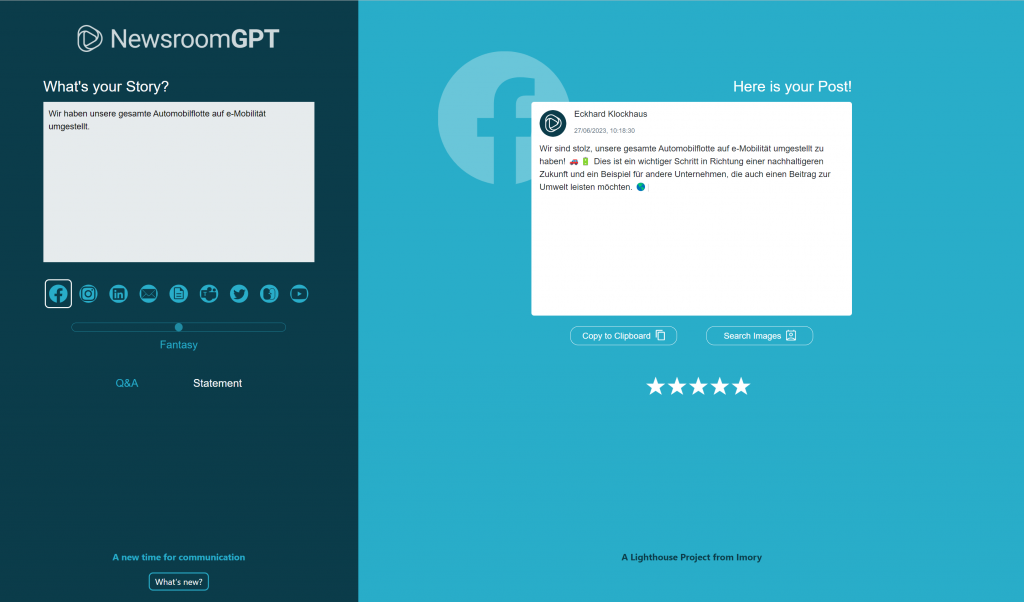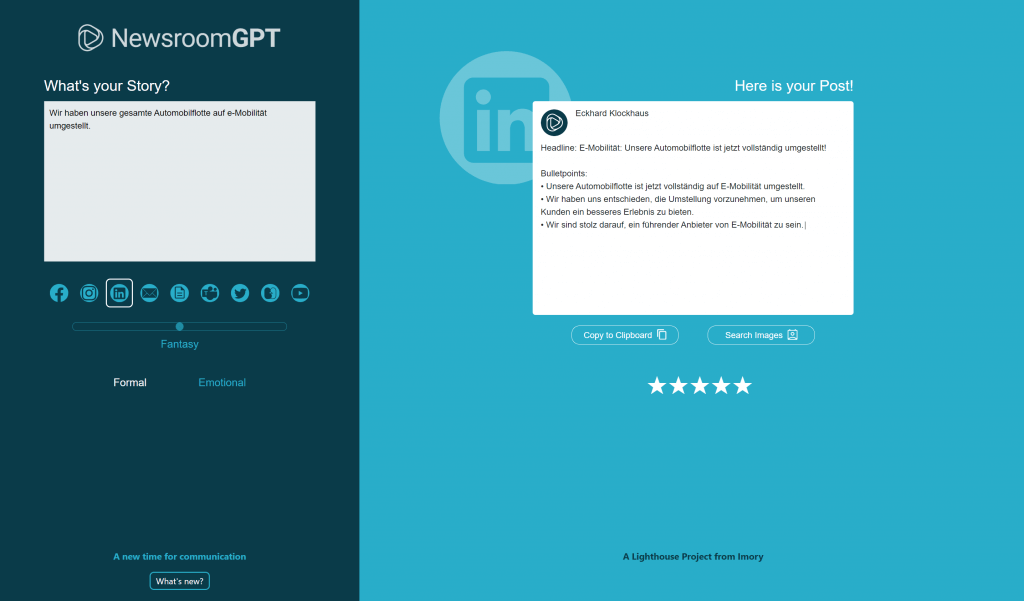- June 29, 2023
- Posted by: Jörg Forthmann
- Category: BEST PRACTICES

Eckhard Klockhaus is founder and CEO of Imory. In an interview with Thomas Mickeleit, he introduces NewsroomGPT, Imory’s first Lighthouse project, and discusses the differences with ChatGPT.
Thomas Mickeleit: Eckhard, thank you very much for your willingness to talk to us about the impact of artificial intelligence in the newsroom. Since ChatGPT was launched in November 2022, we in communications have also noticed – finally – that technologies are knocking very loudly on our door. What is your assessment of this? How loudly does it knock?
Eckhard Klockhaus: I don’t think AI is knocking on the door yet. It is already in the hallway. The impact of AI in communications will be much greater than most people can currently imagine. What we are experiencing right now with ChatGPT is just the first small technical implementation of what language models enable. Right now there is a lot of talk about whether we can automate texting with ChatGPT. Most people understand ChatGPT like a writing robot or a reference book; yet we are dealing with an innovation in computer science the likes of which I have not seen before in the last 30 years. Individual deployment scenarios range from content review, transcriptions, translations, new forms of data analysis to the automated use of plausibility checks. For me it is certain that the media world will be a new one in the near future due to language models. We will soon see solutions that plan, create and play out entire media formats with AI. AI will change our media world. For the recipients and for the media professionals.
Thomas Mickeleit: A few months ago, Imory demonstrated how to mix up newsroom work with the help of AI, namely ChatGPT. For those who don’t have this exactly on their radar – what does NewsroomGPT, as the solution is called, do in its essence?
Eckhard Klockhaus: NewsroomGPT is our first Lighthouse project. At its core, it’s about mapping the newsroom’s topic-centric work with AI. NewsroomGPT is based on the same technology as ChatGPT. But it’s not a chatbot. NewsroomGPT takes on the task of creating the publications in different formats for all channels with the appropriate tonalities from the subject level of a topic description.


Thomas Mickeleit: With the right prompt, ChatGPT also delivers different formats from a base text. What makes NewsroomGPT different from the native application?
Eckhard Klockhaus: With NewsroomGPT, we have separated the language model from the information model. That sounds very technical at first. The point is that companies can use their knowledge data as the basis for content creation. NewsroomGPT learns from the individual data of each company. While ChatGPT accesses only the general – and incidentally outdated – data, NewsroomGPT is able to include the information of the own company. We can be quite specific about the request, format, and tone in ChatGPT with a prompt, but we cannot directly influence the information model. Imagine that the AI knows all your press releases, your posts, your documents and your language rules. That can’t be mapped into prompts.
Thomas Mickeleit: Several companies prohibit the use of ChatGPT because they rightly fear that confidential data will end up on OpenAI’s servers and the system will be trained with it. What is the solution to this problem?
Eckhard Klockhaus: This is why it was so important for us to provide NewsroomGPT, the first application with GPT’s language model in the European cloud. I can well stand companies that forbid their employees to feed the information model with internals.
Thomas Mickeleit: NewsroomGPT is in a beta version and is currently available free of charge. What is the feedback from users?
Eckhard Klockhaus: As I said, NewsroomGPT is a showcase; our Lighthouse project. We provide access free of charge and have very good user numbers. We are currently working with initial pilot companies to integrate many functions into our holistic digital newsroom Imory. The feedback from users is good. There are two priorities in addition to the existing functions of theme-centered work. First, the solution needs to be team-based; it’s not about the individual creating great prompts, but we need a solution that is repeatable and scalable. Second, the solution must not forget what it has already done. All content created with AI can thus be created with consideration to previous content and checked for plausibility.
Thomas Mickeleit: The open interfaces (APIs) to ChatGPT have spurred developers to write what feels like millions of applications. In communication, there are still countless undocumented analog processes waiting to be digitized. Will the LLMs bring us salvation?
Eckhard Klockhaus: The short answer is yes. But we should get a little further into the technology here. According to our research, most current developments are based on automating processes through coded prompts. Such solutions are quickly created, but they only scratch the surface of what is possible. The big steps come when ChatGPT’s technology is deployed in the company’s own cloud environment and when companies incorporate their data model. Another aspect here is also the question of the European cloud. I would not advise companies in Europe to use OpenAI services from America for development that accesses internal company data. GPT in the European cloud is already available. But it is, as so often in software development. The quick fixes have their limitations.
